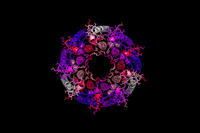
A light-harvesting complex from a bacterium. Image created by Iain Johnston.
In a paper that appeared in the March 15 issue of the Proceedings of the National Academy of Sciences USA, Jonathan Doye, together with Ard Louis in the Department of Physics and collaborators in Cambridge, Exeter, Norway and Kuwait, explore the origins of symmetry and modularity in natural systems. The conventional explanation is that such features are favoured because they provide a selective fitness advantage. Based on a detailed characterization of the genotype-phenotype maps of models of protein complexes, RNA secondary structure and gene regulatory networks, the paper suggests an alternative explanation for the prevalence of symmetry, namely, that genetic variation is strongly biased towards producing symmetric and modular phenotypes because they require less information to encode.
Read the journal article: Symmetry and simplicity spontaneously emerge from the algorithmic nature of evolution
Read about the work in the New York Times and in Le Monde.
Watch a video by Ard Louis discussing the paper.
Read more about the work from the University of Oxford.